headrest HYUNDAI I30 2023 Owners Manual
[x] Cancel search | Manufacturer: HYUNDAI, Model Year: 2023, Model line: I30, Model: HYUNDAI I30 2023Pages: 533, PDF Size: 59.13 MB
Page 22 of 533
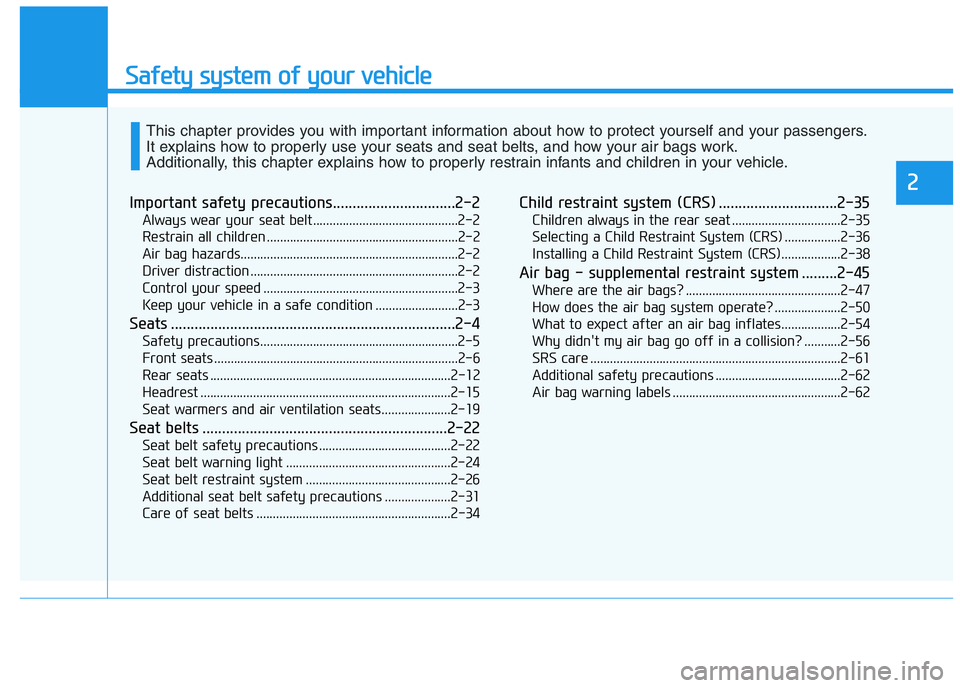
Safety system of your vehicle
2
Important safety precautions...............................2-2
Always wear your seat belt............................................2-2
Restrain all children ..........................................................2-2
Air bag hazards..................................................................2-2
Driver distraction ...............................................................2-2
Control your speed ...........................................................2-3
Keep your vehicle in a safe condition .........................2-3
Seats ........................................................................2-4
Safety precautions............................................................2-5
Front seats ..........................................................................2-6
Rear seats .........................................................................2-12
Headrest ............................................................................2-15
Seat warmers and air ventilation seats.....................2-19
Seat belts ..............................................................2-22
Seat belt safety precautions ........................................2-22
Seat belt warning light ..................................................2-24
Seat belt restraint system ............................................2-26
Additional seat belt safety precautions ....................2-31
Care of seat belts ...........................................................2-34
Child restraint system (CRS) ..............................2-35
Children always in the rear seat .................................2-35
Selecting a Child Restraint System (CRS) .................2-36
Installing a Child Restraint System (CRS)..................2-38
Air bag - supplemental restraint system .........2-45
Where are the air bags? ...............................................2-47
How does the air bag system operate? ....................2-50
What to expect after an air bag inflates..................2-54
Why didn't my air bag go off in a collision? ...........2-56
SRS care ............................................................................2-61
Additional safety precautions ......................................2-62
Air bag warning labels ...................................................2-62
This chapter provides you with important information about how to protect yourself and your passengers.
It explains how to properly use your seats and seat belts, and how your air bags work.
Additionally, this chapter explains how to properly restrain infants and children in your vehicle.
Page 25 of 533
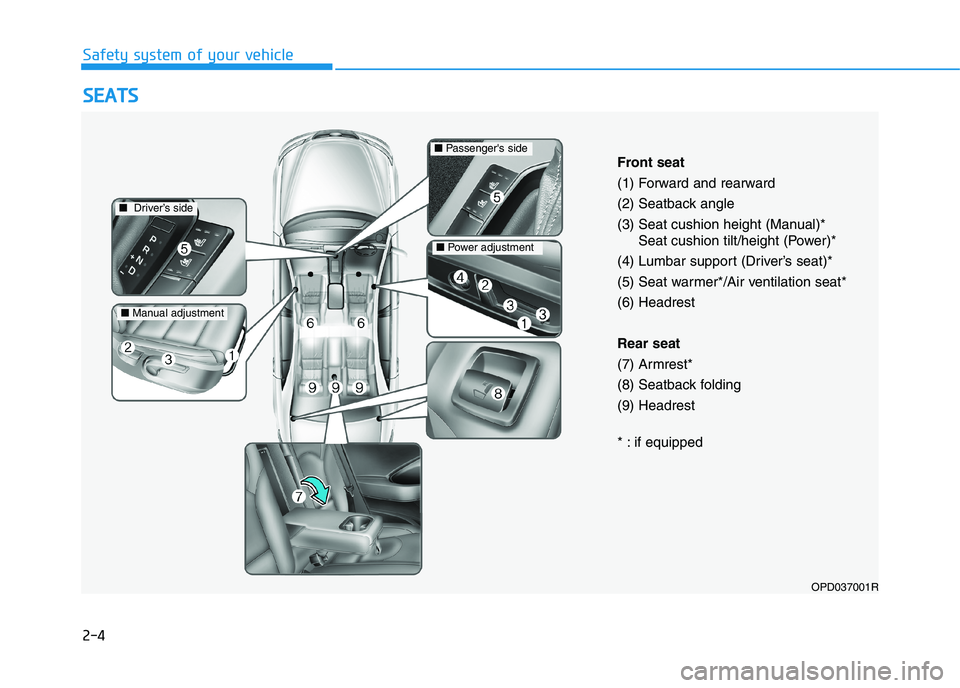
2-4
S SE
EA
AT
TS
S
Safety system of your vehicle
OPD037001R
Front seat
(1) Forward and rearward
(2) Seatback angle
(3) Seat cushion height (Manual)*
Seat cushion tilt/height (Power)*
(4) Lumbar support (Driver’s seat)*
(5) Seat warmer*/Air ventilation seat*
(6) Headrest
Rear seat
(7) Armrest*
(8) Seatback folding
(9) Headrest
* : if equipped
■Driver’s side
■Manual adjustment
■Power adjustment
■Passenger's side
Page 33 of 533
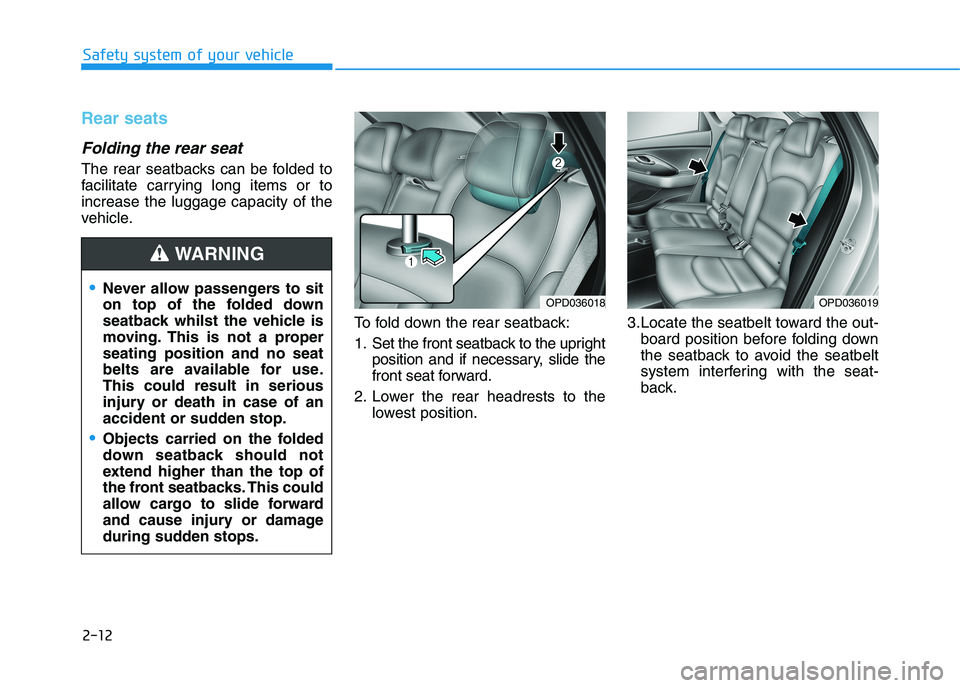
2-12
Safety system of your vehicle
Rear seats
Folding the rear seat
The rear seatbacks can be folded to
facilitate carrying long items or to
increase the luggage capacity of the
vehicle.
To fold down the rear seatback:
1. Set the front seatback to the upright
position and if necessary, slide the
front seat forward.
2. Lower the rear headrests to the
lowest position.3.Locate the seatbelt toward the out-
board position before folding down
the seatback to avoid the seatbelt
system interfering with the seat-
back.
Never allow passengers to sit
on top of the folded down
seatback whilst the vehicle is
moving. This is not a proper
seating position and no seat
belts are available for use.
This could result in serious
injury or death in case of an
accident or sudden stop.
Objects carried on the folded
down seatback should not
extend higher than the top of
the front seatbacks. This could
allow cargo to slide forward
and cause injury or damage
during sudden stops.
WARNING
OPD036018OPD036019
Page 36 of 533
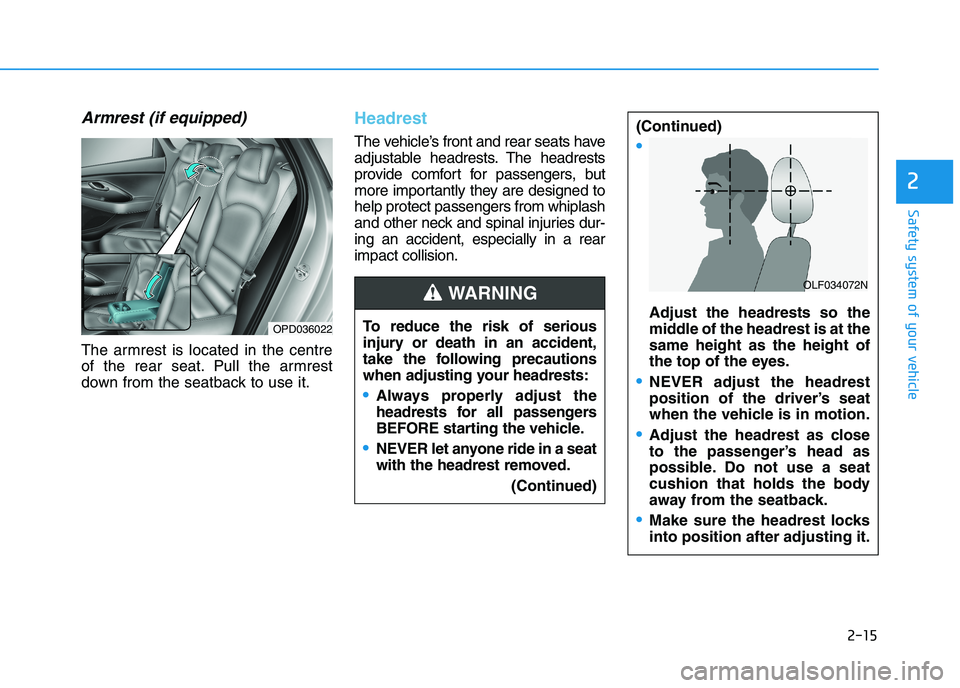
2-15
Safety system of your vehicle
2
Armrest (if equipped)
The armrest is located in the centre
of the rear seat. Pull the armrest
down from the seatback to use it.
Headrest
The vehicle’s front and rear seats have
adjustable headrests. The headrests
provide comfort for passengers, but
more importantly they are designed to
help protect passengers from whiplash
and other neck and spinal injuries dur-
ing an accident, especially in a rear
impact collision.
To reduce the risk of serious
injury or death in an accident,
take the following precautions
when adjusting your headrests:
Always properly adjust the
headrests for all passengers
BEFORE starting the vehicle.
NEVER let anyone ride in a seat
with the headrest removed.
(Continued)
(Continued)
Adjust the headrests so the
middle of the headrest is at the
same height as the height of
the top of the eyes.
NEVER adjust the headrest
position of the driver’s seat
when the vehicle is in motion.
Adjust the headrest as close
to the passenger’s head as
possible. Do not use a seat
cushion that holds the body
away from the seatback.
Make sure the headrest locks
into position after adjusting it.
WARNING OLF034072N
OPD036022
Page 37 of 533
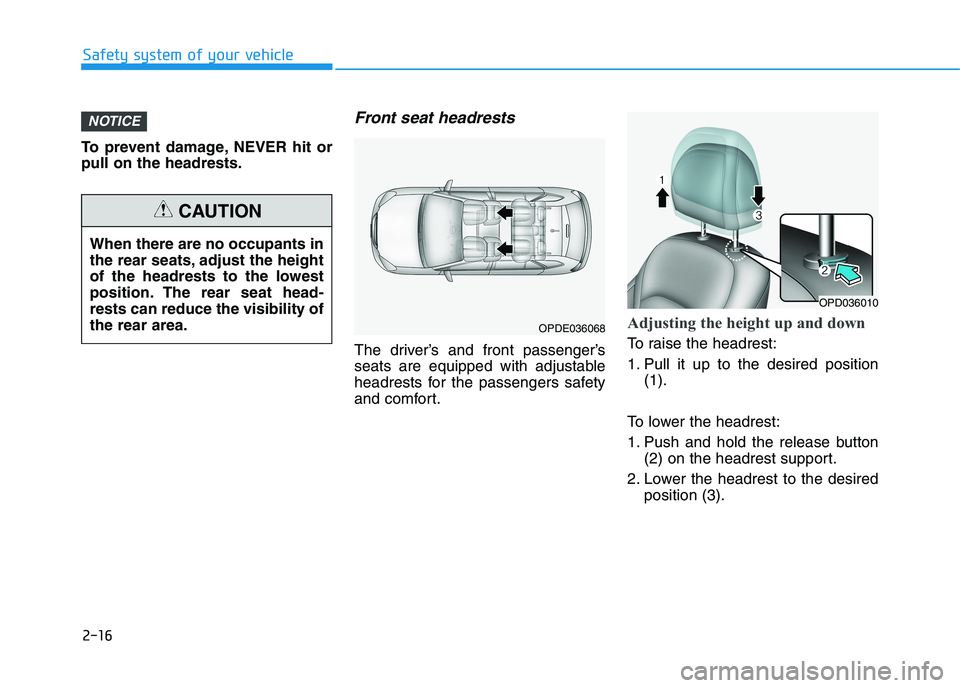
2-16
Safety system of your vehicle
To prevent damage, NEVER hit or
pull on the headrests.
Front seat headrests
The driver’s and front passenger’s
seats are equipped with adjustable
headrests for the passengers safety
and comfort.
Adjusting the height up and down
To raise the headrest:
1. Pull it up to the desired position
(1).
To lower the headrest:
1. Push and hold the release button
(2) on the headrest support.
2. Lower the headrest to the desired
position (3).
NOTICE
OPDE036068
OPD036010
When there are no occupants in
the rear seats, adjust the height
of the headrests to the lowest
position. The rear seat head-
rests can reduce the visibility of
the rear area.
CAUTION
Page 38 of 533
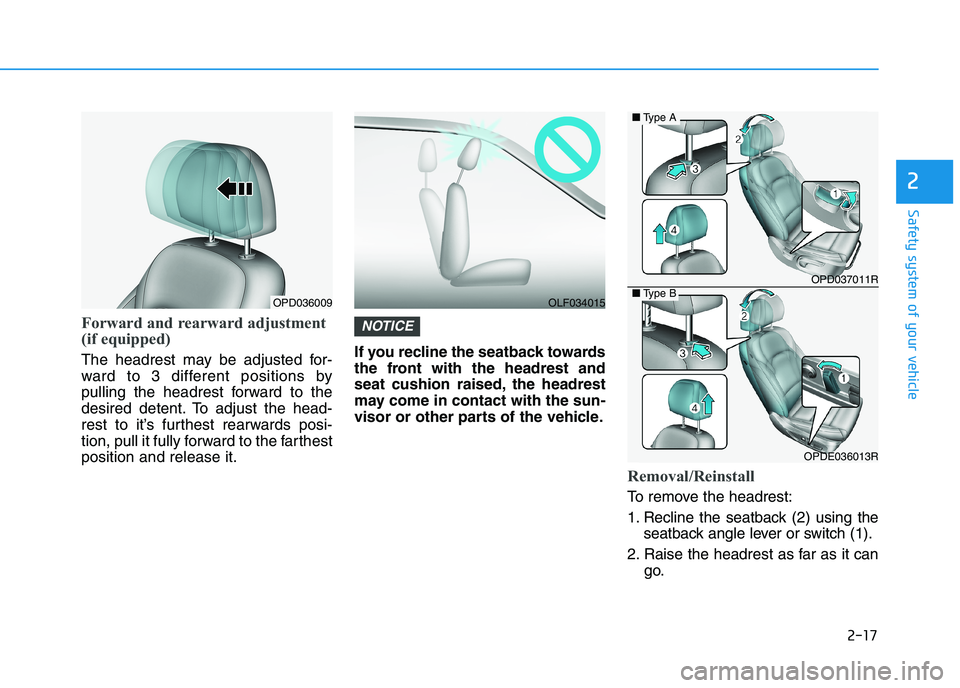
2-17
Safety system of your vehicle
2
Forward and rearward adjustment
(if equipped)
The headrest may be adjusted for-
ward to 3 different positions by
pulling the headrest forward to the
desired detent. To adjust the head-
rest to it’s furthest rearwards posi-
tion, pull it fully forward to the farthest
position and release it.If you recline the seatback towards
the front with the headrest and
seat cushion raised, the headrest
may come in contact with the sun-
visor or other parts of the vehicle.
Removal/Reinstall
To remove the headrest:
1. Recline the seatback (2) using the
seatback angle lever or switch (1).
2. Raise the headrest as far as it can
go.
NOTICE
OPD037011R
OPDE036013R
■Type A
■Type BOLF034015OPD036009
Page 39 of 533
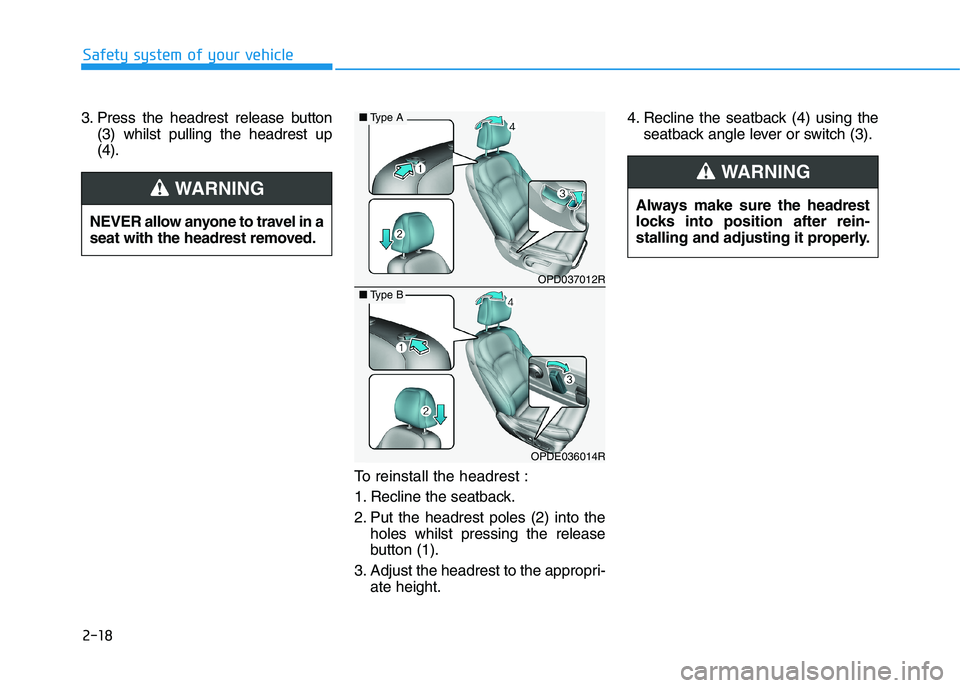
2-18
Safety system of your vehicle
3. Press the headrest release button
(3) whilst pulling the headrest up
(4).
To reinstall the headrest :
1. Recline the seatback.
2. Put the headrest poles (2) into the
holes whilst pressing the release
button (1).
3. Adjust the headrest to the appropri-
ate height.4. Recline the seatback (4) using the
seatback angle lever or switch (3).
Always make sure the headrest
locks into position after rein-
stalling and adjusting it properly.
WARNING
OPD037012R
OPDE036014R
■Type A
■Type B
NEVER allow anyone to travel in a
seat with the headrest removed.
WARNING
Page 40 of 533
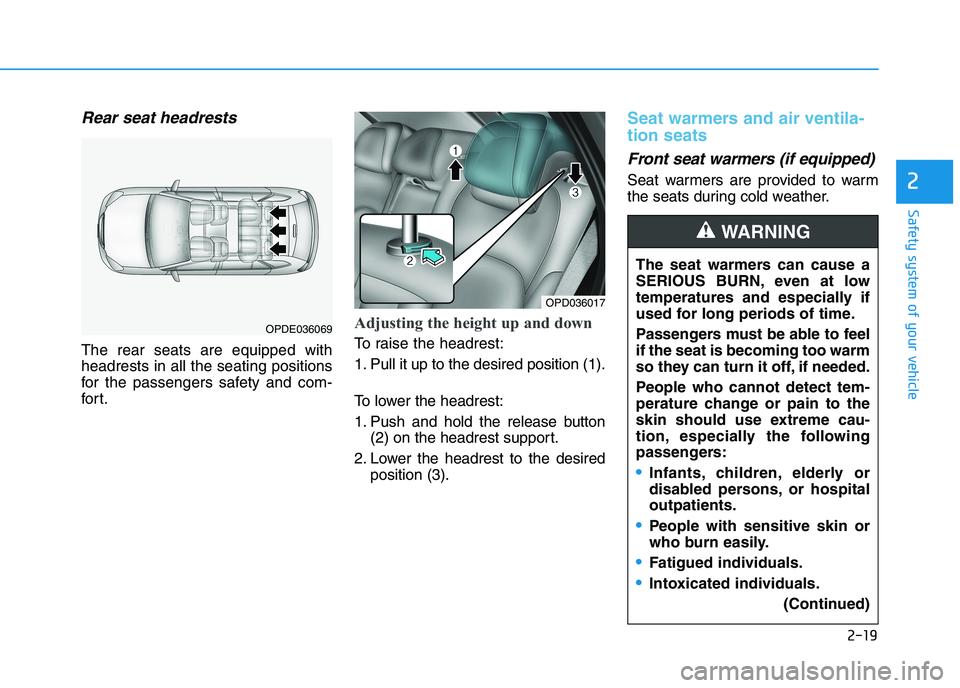
2-19
Safety system of your vehicle
2
Rear seat headrests
The rear seats are equipped with
headrests in all the seating positions
for the passengers safety and com-
for t.
Adjusting the height up and down
To raise the headrest:
1. Pull it up to the desired position (1).
To lower the headrest:
1. Push and hold the release button
(2) on the headrest support.
2. Lower the headrest to the desired
position (3).
Seat warmers and air ventila-
tion seats
Front seat warmers (if equipped)
Seat warmers are provided to warm
the seats during cold weather.
The seat warmers can cause a
SERIOUS BURN, even at low
temperatures and especially if
used for long periods of time.
Passengers must be able to feel
if the seat is becoming too warm
so they can turn it off, if needed.
People who cannot detect tem-
perature change or pain to the
skin should use extreme cau-
tion, especially the following
passengers:
Infants, children, elderly or
disabled persons, or hospital
outpatients.
People with sensitive skin or
who burn easily.
Fatigued individuals.
Intoxicated individuals.
(Continued)
WARNING
OPD036017
OPDE036069
Page 59 of 533
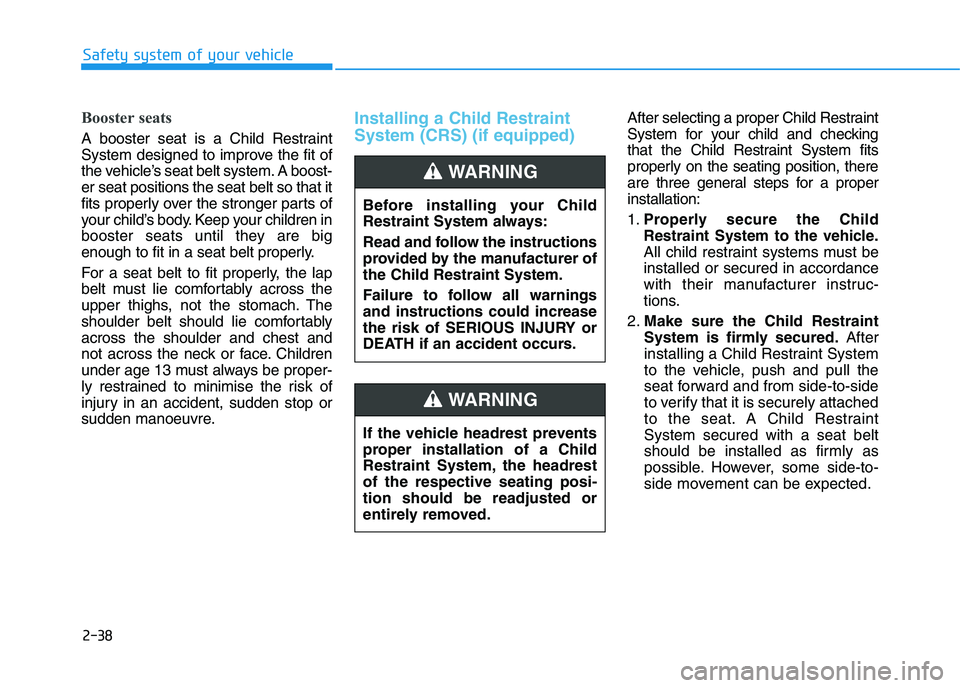
2-38
Safety system of your vehicle
Booster seats
A booster seat is a Child Restraint
System designed to improve the fit of
the vehicle’s seat belt system. A boost-
er seat positions the seat belt so that it
fits properly over the stronger parts of
your child’s body. Keep your children in
booster seats until they are big
enough to fit in a seat belt properly.
For a seat belt to fit properly, the lap
belt must lie comfortably across the
upper thighs, not the stomach. The
shoulder belt should lie comfortably
across the shoulder and chest and
not across the neck or face. Children
under age 13 must always be proper-
ly restrained to minimise the risk of
injury in an accident, sudden stop or
sudden manoeuvre.
Installing a Child Restraint
System (CRS) (if equipped)After selecting a proper Child Restraint
System for your child and checking
that the Child Restraint System fits
properly on the seating position, there
are three general steps for a proper
installation:
1.Properly secure the Child
Restraint System to the vehicle.
All child restraint systems must be
installed or secured in accordance
with their manufacturer instruc-
tions.
2.Make sure the Child Restraint
System is firmly secured.After
installing a Child Restraint System
to the vehicle, push and pull the
seat forward and from side-to-side
to verify that it is securely attached
to the seat. A Child Restraint
System secured with a seat belt
should be installed as firmly as
possible. However, some side-to-
side movement can be expected. Before installing your Child
Restraint System always:
Read and follow the instructions
provided by the manufacturer of
the Child Restraint System.
Failure to follow all warnings
and instructions could increase
the risk of SERIOUS INJURY or
DEATH if an accident occurs.
WARNING
If the vehicle headrest prevents
proper installation of a Child
Restraint System, the headrest
of the respective seating posi-
tion should be readjusted or
entirely removed.
WARNING
Page 103 of 533
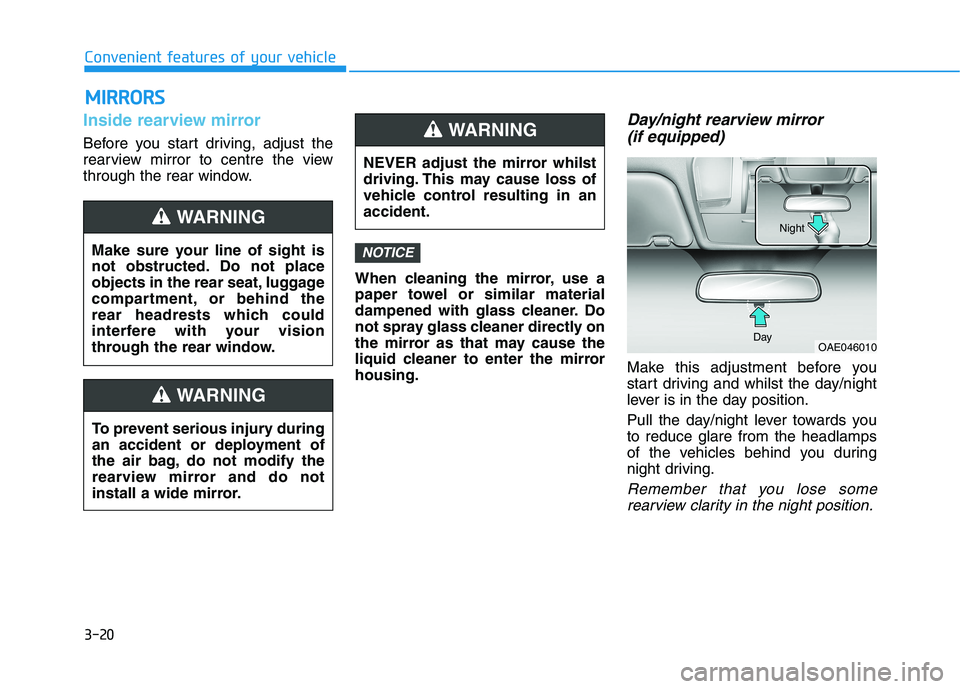
3-20
Convenient features of your vehicle
Inside rearview mirror
Before you start driving, adjust the
rearview mirror to centre the view
through the rear window.
When cleaning the mirror, use a
paper towel or similar material
dampened with glass cleaner. Do
not spray glass cleaner directly on
the mirror as that may cause the
liquid cleaner to enter the mirror
housing.
Day/night rearview mirror
(if equipped)
Make this adjustment before you
start driving and whilst the day/night
lever is in the day position.
Pull the day/night lever towards you
to reduce glare from the headlamps
of the vehicles behind you during
night driving.
Remember that you lose some
rearview clarity in the night position.
NOTICE
NEVER adjust the mirror whilst
driving. This may cause loss of
vehicle control resulting in an
accident.
WARNING
OAE046010 DayNight
M MI
IR
RR
RO
OR
RS
S
Make sure your line of sight is
not obstructed. Do not place
objects in the rear seat, luggage
compartment, or behind the
rear headrests which could
interfere with your vision
through the rear window.
WARNING
To prevent serious injury during
an accident or deployment of
the air bag, do not modify the
rearview mirror and do not
install a wide mirror.
WARNING